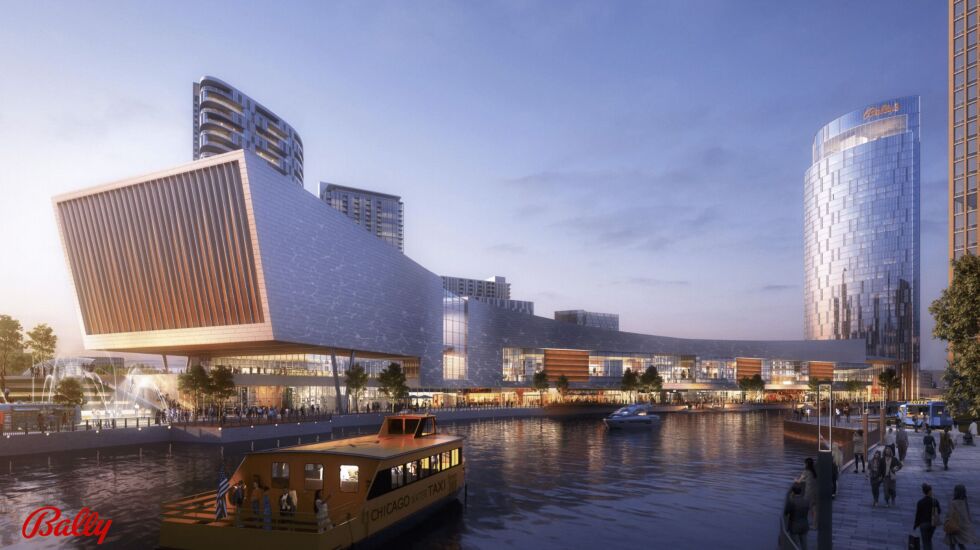The year 2022 was a busy one on the Chicago architecture beat.
The city grappled with trying to figure out the fate of a likely Bears-less Soldier Field, while the CTA took steps to secure funding for the planned $3.6 billion Red Line extension.
And a lot of things happened in between. Here are some of the highlights:
- The Casino: A much-criticized process led to the city’s decision in May to let Bally’s build a casino and entertainment complex on the Chicago Tribune’s Freedom Center site at Chicago Avenue and Halsted Street along the North Branch of the Chicago River. And the architecture? The renderings so far show it to be a low-stakes collection of brightly lit, antiseptic buildings — and a glass tower that’s anonymous enough to be a successful candidate for the witness protection program. A major issue will be making sure the casino buildings don’t wind up creating a gaming compound that blocks (or doesn’t promote) the public’s access to the river.

2. The Century and Consumers buildings: The federal government let these two early downtown skyscrapers at 202 and 220 S. State St., rot after buying them nearly 20 years ago. Then in March, U.S. Sen. Richard Durbin, D-Ill., compounded the sin when he earmarked $52 million to wreck the buildings and replace them with an alleged safety buffer to protect the Dirksen Federal Building, which is located a block west on Dearborn Street. With State Street trying to remake itself as a destination for shopping, outdoor festivals and residential uses, the last thing it needs is a jumped-up vacant lot. Hopefully, the current Section 106 hearings mandated for historic federal properties by the National Historic Preservation Act will result in the buildings being spared from demolition and redeveloped — with Durbin’s $52 million as seed money.
3. Lakeside Center: The Metropolitan Pier and Exposition Authority, staring at $400 million in potential renovation costs for McCormick Place’s oldest convention hall, announced plans in September to find new operators to lease all or part of the architecturally-noteworthy 52-year-old modernist building. The catch is the operators will get saddled with a portion or all of that renovation bill, depending on how much of the building they occupy. And if the operator picks an interior space that’s currently used for conventions — as opposed to, say, the massive outdoor terrace spots, which could be converted into al fresco dining areas — the MPEA would require that business to build replacement exhibition space somewhere on the campus. It would be great to see the building get redeveloped. But only a patsy would say yes to those stipulations. The MPEA should rethink the terms.
What’s worth watching architecturally in 2023?
- The Obama Presidential Center: The 19-acre complex won’t be finished until 2025, but we’ll see more of it take shape next year. And given the complex is covered in so much stone, including that 235-foot tower, it would be nice to finally know what kind because the type of cladding — granite? limestone? — can drastically impact the buildings’ look. But the Obama Foundation has been oddly mum about that when asked. The organization’s website does promise the cladding will be “variegated,” meaning it’ll capture different colors. But we need to know more.
- Former Sears Garden: North Lawndale residents and open space proponents are looking to restore a two-acre garden on Arthington Avenue just east of Homan Avenue that was built in 1907 by Sears & Roebuck, right in the heart of the massive catalog and retail operations the company once operated there. It could take $5 million to rejuvenate the garden, restore its handsome 100-foot-long concrete and wood pergola (complete with Doric columned porticos at each end) and set aside cash for maintenance. But it would be worth it. Even in its now distressed state, the garden is remarkable. A group called Friends of Sears Sunken Garden is behind the effort.
- The 2023 Mayoral Election: Sure, it’s a political story on first blush, but every Chicago mayor since Richard J. Daley has left their impact on the city’s built environment. Mayor Lori Lightfoot, in her first term, hasn’t produced a Millennium Park as did Richard M. Daley, or a downtown Riverwalk like Rahm Emanuel. But her Invest South/West program, billed as a $2 billion effort to rebuild the long-disinvested commercial strips in 10 Black and Brown neighborhoods, is showing some lift now as the city hosts groundbreakings in recent weeks under the program. Invest South/West is certain to continue if Lightfoot is re-elected. But if she’s given the boot by voters, will her successor continue the program? What other initiatives might they push to rebuild neighborhoods, parks, or aid downtown?
Those are my picks for the year’s top architecture stories (and ones to watch in 2023), let us know yours. Send your thoughts to letters@suntimes.com
Lee Bey is the Chicago Sun-Times architecture critic and a member of the Editorial Board.
Want to write a letter to the editor or submit an op-ed for the Sun-Times? See our guidelines.







